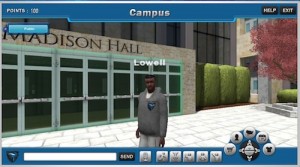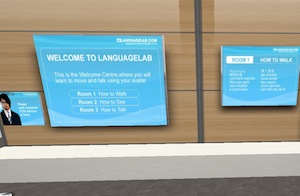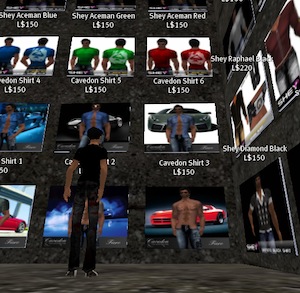I had a note from Andrew Hughes, Adjunct Instructor at the University of Cincinatti and head honcho of Designing Digitally Inc, on the success to date of their 3D Virtual Campus Tours product. Mirror worlds are of course well established and were one of the original ways universities and business have utilised virtual worlds.
Universities in particular are an obvious market, in that new students have a genuine interest in learning how to find their way around, to which virtual environments are ideally suited to help out.
I shot some questions back to Andrew Hughes to get some more information on where 3DVCT sees itself in the marketplace and where it sees its unique value is.
Q: What was the original impetus to develop specifically for campus tours?
A: We have built over 30 campuses inside Second Life, Opensim, and other virtual worlds only to find that we’re not thinking about the convenience factor for novice users. On the web we give around 2 seconds for a website to load before we move on. We were looking to build a browser-based campus and it just so happened that the United States Air Force Academy was looking for a virtual campus tour that was online and completely a browser based replica of their campus. We won the contract and have built a browser-based high end campus tour with built in communication tools and live and AI guided tours.
Q: What sort of response have you had to date from universities, including international universities?
A: We launched the product in March of this year. With the build we have done with the United States Air Force Academy, they have had four thousand recruits through the space at this current time. We have a handful of Universities both in the USA and outside the USA we’re building now but we are under NDA’s with them and cannot disclose their name, the nature of the campus’s needs etc until they are launched on the client’s website.
Q: We have a lot of readers who are educators: can you give a little insight on the platform 3DVCT is built on, including how easy it would be to implement at a university with more restricted IT infrastructure?
A: We’re using the Unity 3D gaming engine and a complex MMO system that is connected to a dynamic server or servers. The development of the system has a complete content management system for users, history, macros for the tours, and even the ability to control the AI bot and what she says within the CMS. The databases are able to fully integrate into an existing CRM or ERM software used by the university so that there is one streamlined process.
We work hard to learn the process from day one of a potential student to the date he or she signs up for the first class. We then build the system to be as integrated and as easy as possible for the University. We also have extensive experience in building in Unity 3D to the extent that we’ve been quoted by their CEO for our talents. The reason I state this as we can change the ports used to adhere to the client’s specifications. We also can cloud the system so that it loads faster and is a little less processor heavy on the end user.
Q: Obviously it will vary but can you give a ballpark cost for a standard university campus tour from development to implementation? And how do you think this compares to other options in the marketplace?
A: Our company is very good at what we do and so we’re in line with any other completely custom built browser-based virtual MMO developer. We also do pricing per enrollment size. So a smaller college will get a discounted rate depending on the pricing of the current student enrollment. Right now there is not a virtual world focused on just giving virtual campus tours. Right now in the industry other virtual campus tours are 360 panoramas or Google overhead maps. An experience like that won’t let the student see how big the dorm room is compared to his or her size, nor would it allow them to actually walk around a to-scale campus to see where everything is and get familiar with the campus by actually walking around in it or talking to a live admin rep through voice and text chat we have built in.
Our virtual space is built in the high end gaming engine called Unity 3D and has had over two years of R&D built into it, so that the process can be done quickly and at a professional level you cannot get from Second Life or any other virtual world out there.
Q: What arguments would you make for your platform as opposed to say a university going it alone and developing an OpenSim grid on which to mirror their university and conduct tours?
A: We have the ability to do the following, unlike the virtual worlds you speak of above:
1. Full AI Technology
2. Control over the avatar experience
3. Custom ability to change ports
4. Higher quality of development
5. Runs in a web browser
6. Does not have a large learning curve to get into the world
7. Fully customizable both interface, experience, branding, etc.
8. Ability to be skinned and placed on your website for full ownership
9. Full content management system for the ability to control bots, users, history user tracking where they were, etc.
This is far beyond what those other platforms could ever do – I state this as we’re well known for our SL and Opensim builds and we found that we cannot recruit students effectively.
Q: What are Designing Digitally’s plans for the coming year?
We are working on 3D training simulations, and virtual worlds for government and corporate clients. Many of them are either under NDA or classified government projects. We will be launching a financial literacy system for people to learn how to manage money, buying houses, etc. This will include both Flash and Unity simulations within it. We are also going to be going to the following conferences:
– ASTD 2012
– SALT 2012
3DVCT will be at:
– Noel-Levitz 2012
– NACAC 2012
———-
So there you have it – the 3DVCT product has hitched its wagon firmly to the Unity3D platform, an obvious trend in the simulation field in particular. For what it’s worth, the time I spent checking out 3DVCT further reinforced to me the responsiveness of Unity3D. It’s not the panacea for everything but it’s dominating some key virtual world niches – which lays down a significant challenge to competitors. That can only be good for the ongoing evolution of the industry.




Recent Comments